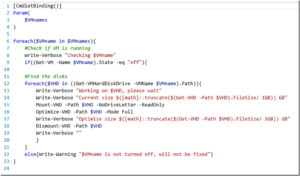Link Script:OptimizeVHDs.ps1

Fonte: https://deploymentbunny.com/2015/06/15/powershell-is-king-compress-compact-optimize-vhd-and-vhdx-files/
Link Script:OptimizeVHDs.ps1

Fonte: https://deploymentbunny.com/2015/06/15/powershell-is-king-compress-compact-optimize-vhd-and-vhdx-files/
1 – Reiniciar a VM e pressionar F8 para entrar em um menu do Windows de seleção de método de inicialização; (no caso da VM, foi necessário entrar via Host, e deixar a VM em modo “Tela Cheia”, para que o F8 fosse interpretado pela VM).
2 – Selecionar a opção Directory Services restore mode;
3 – Irá iniciar a interface gráfica, mas em modo de segurança. Logar com a conta do administrador (local, não no AD);
4 – Abrir o prompt de comando (cmd); Digite então:
cd \windows\system32
NTDSUTIL
Dentro do ntdsutil, digite:
activate instance NTDS
files
Dentro do files, se ainda não deu erro, digite:
checksum
Provavelmente dará um erro, saia então do “files”:
quit
Saia também do ntdsutil
quit
5 – Após verificar o erro, vamos realizar um backup do arquivo ntds.dit antes de mexer nele:
cd\
md backupad
cd \windows\ntds
copy ntds.dit c:\backupad
cd \windows\system32
6 – Rodar então o comando para checar a integridade:
esentutl /g c:\windows\ntds\ntds.dit
7 – Provavelmente o comando anterior retornará um erro. Rodaremos então o comando abaixo para tentar recuperar o arquivo corrompido:
esentutl /p c:\windows\ntds\ntds.dit
Clicar em OK/Aceitar na janela que abrirá.
8 – Copiar os logs (também é possível excluí-los, se for o caso)
cd \windows\ntds
move *.log c:\backupad
9 – Neste momento, a recuperação já deve ter sido realizada com sucesso. Vamos testar:
cd \windows\system32
ntdsutil
Dentro do ntdsutil:
activate instance ntds
files
Dentro do files:
info
Provavelmente mostrará as informações corretamente. Também é possível testar novamente com o checksum, que também deverá rodar com sucesso desta vez.
10 – Como ultimo teste:
Saia do “files”:
quit
Ainda dentro do ntdsutil:
Semantic Database Analysis
Dentro do console que entrar, digite:
Go
Deve rodar sem apresentar nenhum erro.
11 – Após isso, a VM pode ser reiniciada. Ao iniciar novamente, deve subir ok.
Créditos: http://toor.com.br/windows-server-2012-0xc00002e2/
Get-VM -Name Infra2 | select *Memory*
Set-VM -Name Infra2 -DynamicMemory -MemoryStartupBytes 1GB -MemoryMinimumBytes 500MB -MemoryMaximumBytes 2GB
Créditos: http://techibee.com/powershell/increasedecrease-virtual-machine-memory-using-powershell/2084
NET accounts /MAXPWAGE:UNLIMITED
Créditos: http://blog.malevy.net/2010/08/disable-password-expiration-on-windows.html
In order to boot from cd or dvd you need to change the guest virtualization type from HVM (fully virtualized) to PV (paravirtualized).
xe vm-param-set HVM-boot-p olicy="BIOS order" uuid=[uuid of your vm]
After you have booted from dvd, change back to fully virtualized mode:
xe vm-param-set HVM-boot-p olicy="" uuid=[uuid of your vm]
Créditos: http://www.xenlens.com/boot-a-guest-vm-from-cd-or-dvd-in-xenserver
NET accounts /MAXPWAGE:UNLIMITED
Fonte: http://blog.malevy.net/2010/08/disable-password-expiration-on-windows.html
Here’s an example showing its use on IDE:
<code>Add-VMHardDiskDrive -VMName <vm name>-ControllerType IDE -ControllerNumber 0 –Path "<vhd path and name>" -ComputerName <server></code>
This article describes how to add a USB Drive to Citrix XenServer as a Local Storage Repository. This is tested on XenServer versions: 5.0, 5.5, 5.6.
Now you can see it in XenCenter and use it.
[root@xenserver /]# cat /etc/rc.local
# usb_storage
modprobe -r usb_storage
modprobe usb_storage
# auto start vm
# pool auto_start
xe pool-param-set uuid=cb7ba7a3-5cf5-b738-2806-3f74e8d71cfd other-config:auto_poweron=true
sleep 20
# vms manual_start
xe vm-start uuid=b8f68d5c-c764-9135-67a5-a050c397d23f
sleep 20
xe vm-start uuid=c7261f28-1207-59f9-8c29-bd7c1ef7f376
# mount usb_storage
sleep 60
/etc/init.d/usbautomount.sh attach
[root@xenserver /]# xe vm-list
[root@xenserver /]# xe pool-list
[root@xenserver /]# xe sr-list
30 22 * * 0,2,4 /usr/bin/php /usr/local/bin/purgeBackup.php
45 22 * * 0,2,4 /usr/bin/perl /usr/local/bin/backup.pl
Original Script : http://community.citrix.com/display/xs/0+downtime+snapshot+based+
XENServer+5.5+backup+script.
Script Modificao : xenserverbkp.tar.gz
